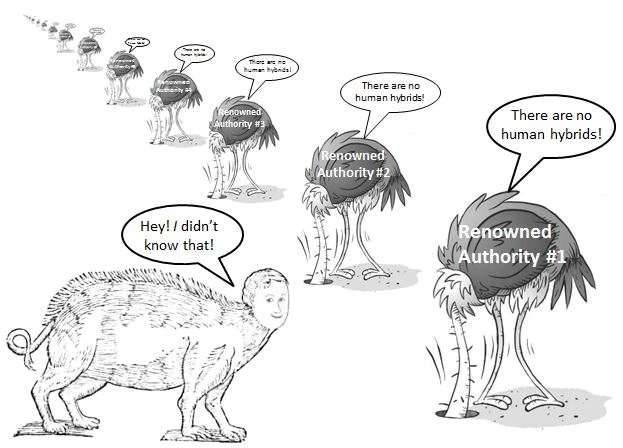Pig-human Hybrids
Historical reports
Mammalian Hybrids
Some readers may find the contents of this page disturbing.
|
Sows can give birth to piglets with human heads.
—St. Albertus Magnus
Physica (2.3.3) |
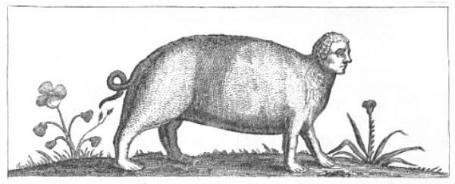 A creature with both human and porcine features supposedly born at Liege in the year 1110 A.D. (source: Liceti 1607, II, p. 183).
A creature with both human and porcine features supposedly born at Liege in the year 1110 A.D. (source: Liceti 1607, II, p. 183).
 John Locke
John Locke(1632-1704)
No less a personage than the great philosopher John Locke gave credence to the existence of pig-human hybrids. In his Essay Concerning Human Understanding (1690, III, Chapter 6, §27) he asks, “Who would undertake to resolve what species that monster was of, which is mentioned
Becmann. And the German chronicler Johann Christoph Becmann, a professor at the University of Frankfurt, states (Historische Beschreibung der Chur und Mark Brandenburg, 1751, Volume 1, p. 883) that in the marketplace at Prenzlau, on July 15, 1587, a sow farrowed a piglet with a human head. He also says (ibid.) that similar births occurred in Berlin in 1647, in Golnau, Pomerania, on May 19, 1652, and near Havelberg, in 1719.
Floyer. In 1699 the English physician Sir John Floyer (1649-1734) authored an account (Floyer 1699) of two supposed human-pig hybrids (Philosophical Transactions of the Royal Society, vol. 21). There he states that “In May 1699 there was shewed to me a Pig, at Weeford in Staffordshire, with
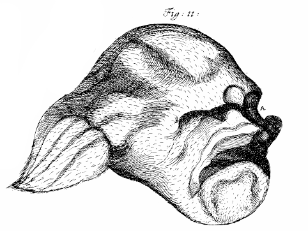
|
|
Head of an alleged man-pig (Floyer 1699) |
Floyer himself, ascribed the human-like heads of these piglets to “compression of the Womb” (that is, as Floyer explains, pressure on the piglet’s head from the uterus, placenta or adjacent piglets). But from his account, it’s clear that others believed these animals to be pig-human hybrids. He says one, a male, was born alive but died soon thereafter because he could not nurse.
It’s of interest that the shape of the head of the animal as described by Floyer and as pictured in his illustration (see figure, above right) is similar to that of the “monkey-pigs” pictured on another page of this website (“the same Chin, and depression betwixt the Eyes, and the roundness of the Head and flatness of the Ears”). However, if his animals were in fact hybrids, it’s clear that in England in 1699 the nonporcine parent would not have been a monkey. Floyer notes that the sex of the Derbyshire “piglet” could not be determined, but that the Weeford animal was a male.
London. An anonymous 1676 pamphlet announced the birth in London of a pig with human-like features. From the description given, it’s clear that the specimen in question did not differ much in its appearance from many other putative pig-human hybrids, that is, its skin was soft and smooth as a baby’s, a frontal proboscis was present, the face and skull exhibited various human-like features, and the hooves were curled up in front. As in many other reports about distant hybrids, the specimen in question was anophthalmic, that is, it lacked eyes (more cases of anophthalmia and cyclopea in pig-human mixes).
|
An abnormal Puritan psychology led to all kinds of repression, furtiveness, & grotesque hidden crime, while the long winters & backwoods isolation fostered monstrous secrets that never came to light.
—H. P. Lovecraft
Letter to Elizabeth Toldridge§ |
New Haven, Connecticut. In the Records of the Colony and Plantation of New-Haven, from 1638 to 1649 (Hoadly 1857), in an account of the court trial of one George Spencer (pp. 62-63), which took place in New Haven on March 2, 1641, there is an account of a probable pig-human hybrid, a cyclops:
Having been found guilty, Spenser was hanged, and the mother sow, too, was put to death (see Hoadly 1857, p. 72). In such cases the animal “accomplice” was often executed as well. The religious motives behind this seemingly needless punishment of a brute animal were spelled out by the Jewish scholar Philo Judaeus (The Special Laws, III, 8:46):
Another New Haven case, also cyclopean, is found in Dexter (1917, vol. 1, pp. 158-159). In that book, this record for the general court session for January 15, 1652, appears:
And two additional likely cases are briefly mentioned in Hoadly (1857, p. 295), where, in the record of the courtroom examination of a suspect taking place on February 1, 1646, there is mention of "a sow of Mrs. Lambertons pigging two monsters, one of them had a faire & white skinne & head [and] another [had] a head lik that of a childe."
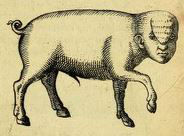 An alleged pig-human hybrid that, according Johann Georg Schenck, was born on Cyprus near Nicosia, on Dec. 12, 1568, along with four normal piglets. (source: Monstrorum historia memorabilis, 1609, p. 113, fig. 85). The structure shown on the forehead may represent a frontal proboscis.
An alleged pig-human hybrid that, according Johann Georg Schenck, was born on Cyprus near Nicosia, on Dec. 12, 1568, along with four normal piglets. (source: Monstrorum historia memorabilis, 1609, p. 113, fig. 85). The structure shown on the forehead may represent a frontal proboscis.
Nicosia. Johann Georg Schenck (1609, pp. 113-114) lists seven old cases of pigs born with human heads. One of these, he says, the creature pictured at right, was born near Nicosia on the island of Cyprus in the year 1568.
Germany. Johannes Praetorius (Neüliche Miß-Geburten, 1678) reports three pig-human hybrids born in Germany. One was a piglet born with a human head on the twentieth of June, 1678 in Rinteln [a small town in Lower Saxony]. The other was a "half a pig and half a man" farrowed on a farm outside Mühlhausen. A third was born in Eisleben in the fall of 1669, a child with the snout of a pig.
China. An additional case is listed in Chinese records of the Shanghai region, a pig born in the year 1600 with a human head and hands (Macgowan, 1860, p.70). Also there is an early twentieth-century report about Chinese Buddhists interpreting a pig with a human hand as an accursed reincarnation.
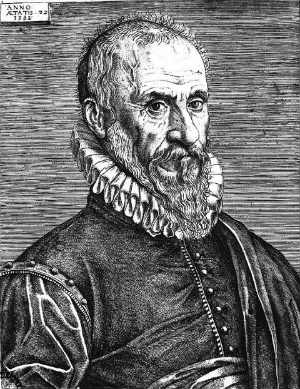 Ambroise Paré
Ambroise Paréc. 1510 – 1590
Brussels. French surgeon Ambroise Paré (1646, pp. 665-666) describes a Belgian case:
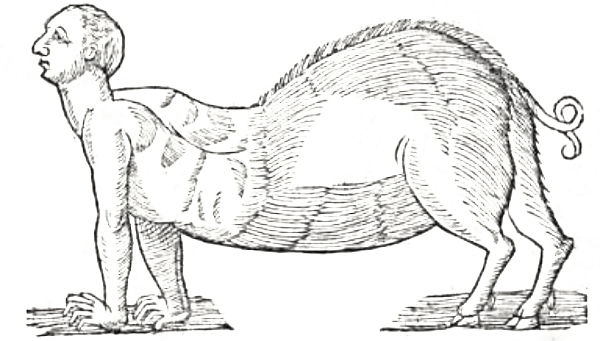 Pig-human hybrid that Paré says was born in Brussels in the year 1564 (Paré 1646, p. 665).
Pig-human hybrid that Paré says was born in Brussels in the year 1564 (Paré 1646, p. 665).Charing Cross. Sir John Hayward, in his Annals of the First Four Years of the Reign of Queen Elizabeth, writes that in the year 1562, “a sowe farrowed a pigge having hands and fingers like a man child” (Crawford 2005; Hayward 1840, vol. 7, p. 107). A contemporary account of this “piglet” published in a broadside that same year reads as follows:
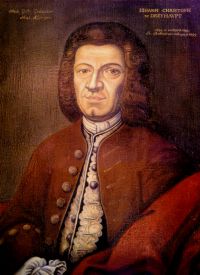 Von Dreyhaupt
Von Dreyhaupt1699 – 1768
Moritzburg. The German historian Johann Christoph von Dreyhaupt, in his treatise on his native Halle (Beschreibung des Saalkreises, 1755, vol. I, p. 645), states that a piglet with a human head was born in that city in 1523. He goes on to say that
 Moritzburg Castle, Saxony, Germany
Moritzburg Castle, Saxony, Germany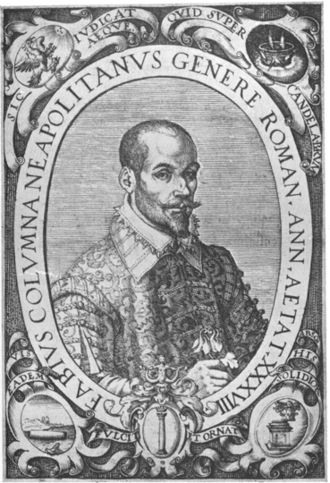 Fabio Colonna
Fabio Colonna1567 – 1640
Italy. The Italian naturalist and botanist Fabio Colonna described a pig-human hybrid born in Italy (Phytobasanos siue Plantarum aliquot historia in qua describuntur diuersi …, Appendix: Piscium aliquot plantarumque novum (Neapoli, 1592), p. 5). The following is a translation of the relevant portion of the text:
Liège. Paré (1646, pp. 665-666) mentions an early case “In the year 1110 a sow in the town of Liège [Belgium] farrowed a pig having the head and the face of a man, as well as human hands and feet, but the rest was like a pig.” His illustration of this animal appears below.
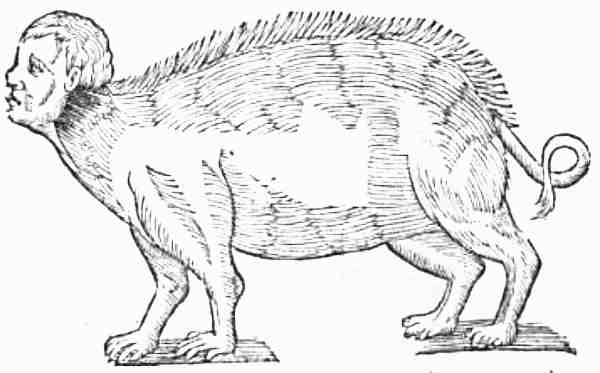 An additional artist’s conception of the pig-human hybrid of Liege (Paré 1646, p. 665), also pictured at the top of this page.
An additional artist’s conception of the pig-human hybrid of Liege (Paré 1646, p. 665), also pictured at the top of this page.
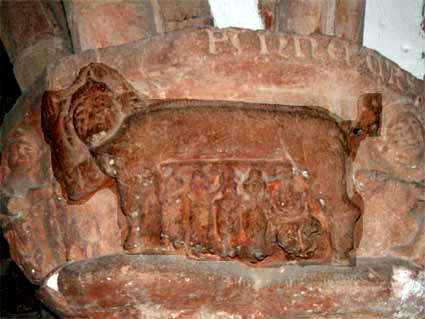 A medieval pig-human hybrid with pig body and human head and hands (Cathedral of St. Peter and Paul, Brandenburg an der Havel, Brandenburg, Germany, circa 1230 AD).
A medieval pig-human hybrid with pig body and human head and hands (Cathedral of St. Peter and Paul, Brandenburg an der Havel, Brandenburg, Germany, circa 1230 AD).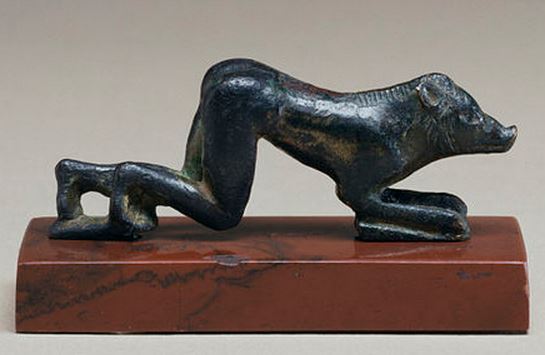 Human-pig hybrid (Greece, 5th century, B.C., Walters Art Museum, Baltimore, Maryland).
Human-pig hybrid (Greece, 5th century, B.C., Walters Art Museum, Baltimore, Maryland).
Ancient times. There are also various classical references to such births. Thus, the Roman historian Livy reports that a pig with a human head was born at Sinuessa in 198 B.C. (Livy 31.12, 32.9), and another at Tarquinii in 210 B.C. (Livy 27.4).‡
And long before the Romans, Akkadian omen lists specified the consequences of sexual connection between humans and pigs (Freedman 2017, p. 72).
Some thoughts
Variation. Note that in all reports of human-pig mixes cited on this page, the mother is a sow and it is the forepart of these tertium quids that resembles humans and the rear, pigs. There is, however, a good bit of variation among the accounts with respect to how much of the forepart is human, varying from cases where a single foreleg bears a human hand, up to cases where both forelegs do, and the head and face bear a perfect resemblance to the human condition. A 18th century case reports the presence of a human ear on one side and a pig ear on the other (as did news stories about a birth at Friendship, Tennessee in 1877). There is also variation with respect to the presence/absence of a frontal proboscis, which seems to be reported in something less than half the cases.
However, there are a few reports on record about human mothers giving birth to half-human half-pig creatures, and it is interesting that in such cases the structure of the body is usually said to be reversed, that is, the foreparts are pig-like and the hind parts are human-like.
Asymmetry in hybrids: There are various cases known, where hybridization produces an asymmetry in body parts similar to those seen in some of the alleged hybrids listed on this page. For example, in my book on avian hybrids (McCarthy 2006), I mention a hybrid between Laysan Albatross (Diomedea immutabilis) and Black-footed Albatross (D. nigripes). This composite individual had one black foot, while the other resembled that of a Laysan. Similarly, a goldeneye-hooded merganser hybrid (Bucephala clangula × Lophodytes cucullatus) had scalation on one leg like a goldeneye, but the other leg was like L. cucullatus (ibid.). There are many other cases (documented on this website) in which mammalian hybrids have appendages differing in a similar way, that is, in having a left foot/leg like that of one parent, but a right foot/leg like the other. As might be expected, asymmetry can affect other portions of the body as well. For example, Mengel (1971, p. 324) mentions an F₁ dog-wolf hybrid (Canis familiaris × Canis latrans with asymmetric teeth (C though M2 much longer on left side). And Handy et al. (2004) reported increased levels of asymmetry in plant hybrids.
What, exactly, is a human being? At the top of this page, the philosopher John Locke was quoted to show that he accepted man-pigs as real. Given that belief, it is not surprising that within the context of philosophical debate he argued that no one really knows exactly what a human being might be: “So far are we from certainly knowing what a man is; though perhaps
By the same author: Handbook of Avian Hybrids of the World, Oxford University Press (2006).
§ October 9, 1932, Selected Letters, III, 423.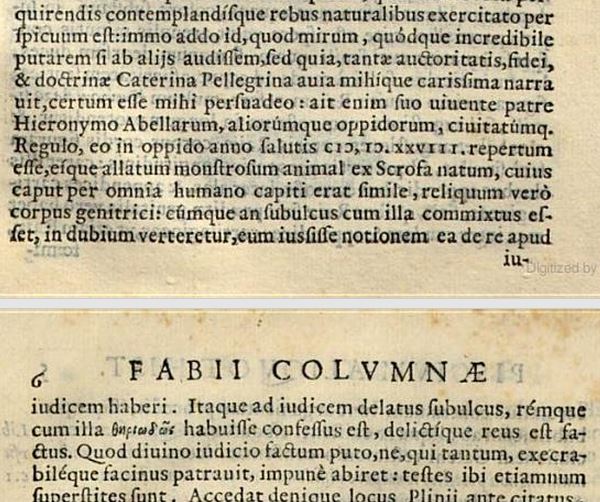
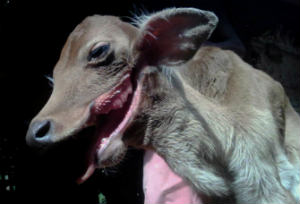 Dog-cow hybrids?
Dog-cow hybrids?
